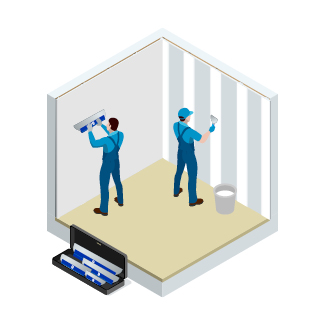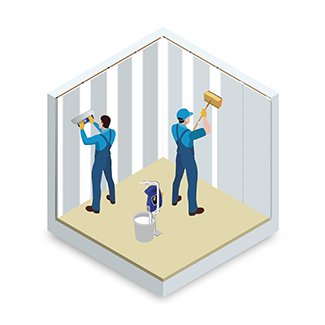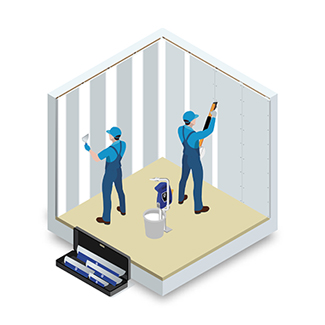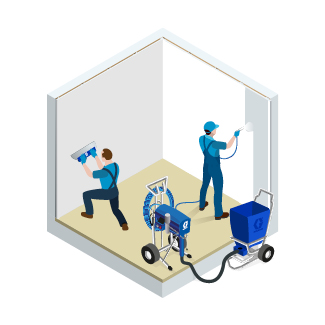Manual versus more automated drywall finishing tools
Are you a manual drywall finisher, do you use automated tools, or are you somewhere in between? It likely depends on the size and frequency of your jobs … and on how you were taught the trade. Stepping up to automation may feel somewhat out of your comfort zone. Read on to learn why and how to make the shift.
Within one job, specific surfaces can be finished with automatic tools, while other parts will require manual finishing. Maybe you often work in small spaces or places with many angles and edges? Are you mainly working on small patches or uneven surfaces, or do you finish large new surfaces? There‘s a suitable tool for any kind of finishing task. Some come in manual and more automated versions; others can be connected to powered pumps to make the job easier.
How not to get lost in the world of finishing tools
You might already be aware that (semi-)automatic tools will help you work faster and more easily, give a more consistent finish, and reduce fatigue as well as the risk of long-term injuries. But where to start and what to consider?
Manual still does the job!
Whatever your reasons to work manually, make sure you use good quality tools, as they are essential to delivering a professional job. And, if you decide to add some automation to your tool set, hold on to those knives, pans, trowels, and blades for small spaces, awkward corners, or touch-ups.
Semi or fully automatic, or a bit of both?
When taking steps towards more automation, you can consider various options:
- If you want to take a small step away from hardcore manual tape and mud work, a banjo taper is a useful tool to consider.
- Using flat boxes allows you to work faster and more easily than with just trowels and knives. Automatic flat boxes make the work even less strenuous.
- Adding more ATF tools or automatic taping and finishing tools to your tool set, like a compound tube or an automatic taper, will boost your speed of work, allowing you to work those large surfaces much more quickly while suffering less fatigue.
- Transferring the joint compound to the ATF tools is done with a loading pump. Manual pumps, however, still require a substantial amount of physical effort. A powered pump might be worth considering as an alternative here. It reduces the physical strain substantially and saves you lots of time.
Tools for any Q level required
When you want to substantially accelerate speed while reducing physical strain, you might want to consider investing in a continuous flow system. This will allow you to:
- work much more easily and quickly
- do larger jobs
- finish surfaces up to Q level or quality level 2
These systems come in different shapes and sizes, with a powerful pump to mix and transfer compound.
Skim coating jobs benefit from powerful airless spray pumps
When you do a lot of skim coating, required for Q level 4 finishing – especially when it comes to large surfaces – manual work is very labour-intensive and time-consuming. For fully manual workers, it won’t be easy to keep up with competitors using automatic tools. That's why it could be worthwhile investing in a powerful airless spray pump combined with a high-end gun. These can also be connected to ATF tools and thus be used for the lower Q level 2.
A small step towards automation might mean a big step for your business
We are all creatures of habit. Getting used to more automatic tools might seem too big a step to take. Still, it’s worth staying informed about the benefits (semi-)automatic tools can bring:
- They make your work easier and faster.
- They reduce the strain and physical risks that come with the job.
- If you’re struggling to upscale your business, the right investment might give you the leverage to make it a success.
But always choose reliable brands that offer – as well as robust tools that will last longer – good tutorials and support. This will help you to get the most out of your new tools as quickly as possible. And if your accountant advises against larger investments, or you are in doubt about which tool to choose, consider renting as an interesting alternative. It will help you to decide between available options or help you get used to working with a specific tool.
Gradually move from manual to automatic drywall finishing

The essentials when working manually:
- Even if you integrate more automation, always keep a set of knives, pans, trowels, and skimming blades at hand for those smaller places or touch-ups

Small steps away from working purely manually:
- A banjo taper speeds up the manual tape and mud work.
- Drywall flat boxes allow you to work more quickly and easily than with just trowels and knives.

Towards semi-automatic tools:
- Switch to additional ATF tools or automated taping and finishing tools for ease, speed of work, and larger surfaces in one go.
- Manual loading pumps (for filling ATFs) still require a great deal of physical effort, so consider a battery-driven pump.

Fully automatic tools:
- Continuous Flow Systems are the next level up in ease and speed of work for carrying out finishes up to Q2 level.
- When offering or aspiring to Q4 level skim coat finishing, invest in a powerful airless pump combined with spray guns and do large surfaces in the blink of an eye.
related articles
Are automatic drywall finishing tools worth the investment?
What benefits can you expect from investing in automatic drywall finishing tools?
3 reasons to invest in an automatic loading pump for drywall finishing
What are the three main reasons to invest in an automatic loading pump for drywall finishing?
Biggest time-saving tools for drywall finishers
Do you know what the biggest time-savers in drywall finishing are?






